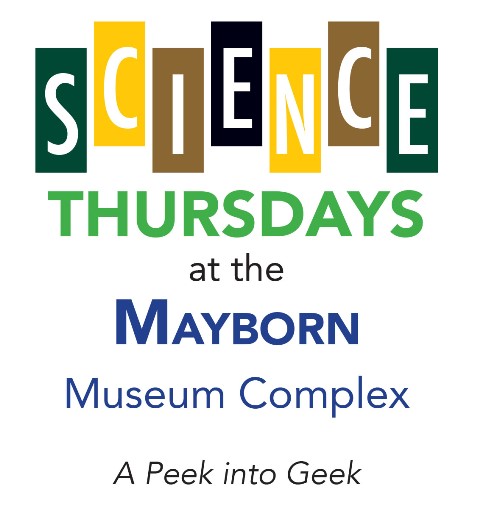Sleep, the Solar System Examined in Mayborn Museum's Science Thursdays

Follow us on Twitter: @BaylorUMedia
Media Contact: Tonya Lewis (254) 710-4656
WACO, Texas (Feb. 2, 2016) – What do carbon dioxide, sleep loss and algae have in common? All are topics of this semester's Science Thursdays at the Mayborn Museum.
Science Thursdays is a series of hour-long lectures, sponsored by the Baylor physics department, on varying scientific topics. The talks will take place from 7 to 8 p.m. on Feb. 4 and 18, March 3, 17 and 31 and April 14 at the Mayborn Museum Complex. Cookies and coffee are available beforehand at 6:30 p.m.
"Our purpose in creating the series is to inform interested, educated members of the public about cutting-edge research in various science areas. It also gives us an opportunity to showcase research that is being performed in our Baylor science departments," said Greg Benesh, Ph.D., professor in the department of physics. "We hope that the public will acquire a broader understanding of the scientific areas presented and that they will be excited by the discoveries and applications that continue to be made."
This semester's talks are:
• Feb. 4: The Sleeping Brain by Michael Scullin, Ph.D., assistant professor of psychology and neuroscience and the director of the Sleep Neuroscience and Cognition Laboratory at Baylor. Scullin will discuss why we need sleep, what your brain does while you're asleep and why a lack of sleep has a negative effect on memory and mood.
• Feb. 18: Low Cost (But High Tech) Tools to Help Blind Children See and Learn by Bryan Shaw, Ph.D., assistant professor in the chemistry and biochemistry department. Shaw will talk about tools being used by medical professionals to help diagnose ocular conditions more quickly in infants and help them get a head start in their education.
• March 3: Death and Forensic Science by Lori Baker, Ph.D., associate professor of anthropology and the founder and executive director of the International Consortium for Forensic Identification Reuniting Families Project. Baker's lecture will cover the factors that contribute to large human migrations and the science used to identify undocumented migrants.
• March 17: Carbon Negative Chemicals and the Fuel for the Fight Against Climate Change by Bill Hockaday, Ph.D., assistant professor in the department of geology. Hockaday will highlight the potential for carbon negativity using pyrolysis, a renewable energy technology that may be able to remove more CO2 from the atmosphere than it emits.
• March 31: How to Build a Solar System by Lorin Matthews, Ph.D., associate professor of physics, will cover how planetary systems form and whether there is another Earthlike planet out there.
• April 14: When Blue Water Turns Green, by Owen Lind, Ph.D., professor of biology. Lind's lecture will be on the aging of lakes and the subsequent algae abundance in those lakes, and the consequences the algae has on aquatic and human health.
The first lecture, which covers sleep and its effect on the brain, will be this Thursday.
"I hope students will discover that sleep is not time wasted, but rather a critical period of time in which your brain prepares you to succeed the next day," Scullin said. "We will cover many ways in which individuals can improve their sleep and I hope attendees will apply that to their own lives."
Scullin chose to lecture on sleep because of its importance to the brain and cognitive functioning and because he considers it "one of the most fascinating aspects of being a human."
"One of the most remarkable things about sleep is that the brain doesn’t turn itself off - in some ways the brain is even more active during sleep states than while we are awake," he said. "The mysteries of what the brain does while you are asleep are beginning to be solved, and I’ll leave that as a cliffhanger to encourage students to attend."
Students need no scientific background to attend the lectures.
"I hope that participants will gain a spark of interest in a topic and continue to pursue a passion for lifelong learning," said Rebecca Nall, assistant director of communications for Mayborn Museum Complex.
Science Thursdays began last year under the initiative of Meera Chandrasekhar, Ph.D., the 2014 winner of the Robert Foster Cherry Award, who taught in the physics department during the spring 2015 semester.
"The Mayborn Museum is so fortunate to be able to partner with the physics department on such a worthwhile endeavor," Nall said. "I can’t wait for Dr. Lorin Matthews' talk on March 31 - sounds fascinating!"
The Mayborn Museum Complex is located at 1300 S. University Parks Dr., Waco, TX 76706.
by Jenna Press, student newswriter, (254) 710-6805
ABOUT BAYLOR UNIVERSITY
Baylor University is a private Christian University and a nationally ranked research institution, characterized as having “high research activity” by the Carnegie Foundation for the Advancement of Teaching. The University provides a vibrant campus community for approximately 16,000 students by blending interdisciplinary research with an international reputation for educational excellence and a faculty commitment to teaching and scholarship. Chartered in 1845 by the Republic of Texas through the efforts of Baptist pioneers, Baylor is the oldest continually operating University in Texas. Located in Waco, Baylor welcomes students from all 50 states and more than 80 countries to study a broad range of degrees among its 12 nationally recognized academic divisions.
ABOUT MAYBORN MUSEUM COMPLEX
Located on the Baylor University campus, the Mayborn Museum Complex features a natural science and cultural history museum focusing on Central Texas with walk-in dioramas, including one on the Waco Mammoth Site, and exploration stations for geology, paleontology, archaeology, and natural history. In addition, 17 themed discovery rooms encourage hands-on learning for all ages.